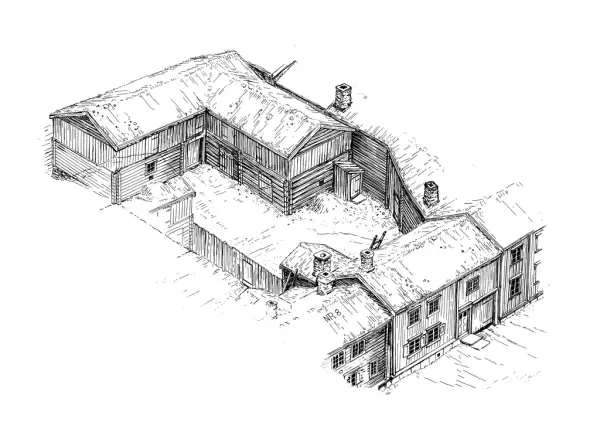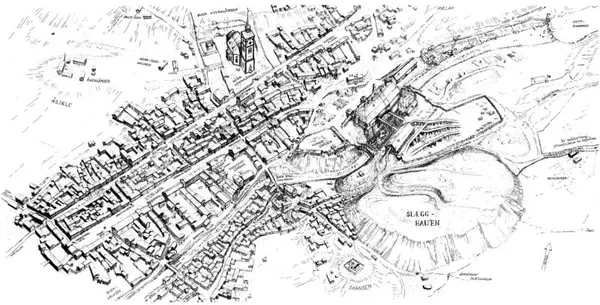- 1/1
-
A typical farm in the mining town with living quarters in the front, and barn, stable and outhouse behind the farmhouse. Illustration: Sverre Ødegaard
The farms
All the the available resources had to be exploited in order to create a sustainable society around the copper works. The workers at the smelter and mines also had to become farmers, building their farm houses close to one another along the two main streets of the mining town. The plots surrounding the town was cultivated for fodder to the livestock during winter. Many of the sheds for the winter hay are still present on the plots outside Røros. Combined with summer farms in the surrounding hills, these small mountain farms provided an essential basis for survival in the barren landscapes. The Copper Works provided other necessities such as grain and salt to the workers and their families.
-
The urban landscape of Røros in the mid of the 19th century. Illustration by Sverre Ødegaard.
The urban structure
The farms were constructed in similar ways as the existing mountain farms in the region, and both the farms of the works' management and the workers were structurally similar, although different in size. The proximity of the farms in the town-like structure is unique in Norway. Bringing international trends to Røros, the Copper Works planned the urban structure. Reminiscent of the renaissance ideals, the town were originally strictly mapped in straight rectangular fashion. Burnt down twice in 1678 and 1679 by Swedish troops, the town was reconstructed influenced by the baroque era. Since then, the town has been spared from great fires, leaving the baroque structure intact to present day.
Preservation
Already during the first period of national preservation regulations in the 1920s, parts of the wooden architecture in Røros were listed - the recognition of the historical value of the mining town dates back a long time. This was also the basis of the inscription of the mining town of Røros on the World Heritage List in 1980. More recently, the cultural landscape surrounding Røros has come under protection, and the world heritage site was expanded in 2010 to include wider areas. The traces from the mining activities (deforestation, the slag heaps, the cable way and other installation in the mining areas) are still visible in the landscape. Likewise, the farming plots around the town and the summer farming in the surrounding hills have provided an unique character to the area. Combined, the landscapes and remnants provide an intuitive picture of 333 years of mining activities in Røros.
- 1/1
The present town structure.



